James Fisk
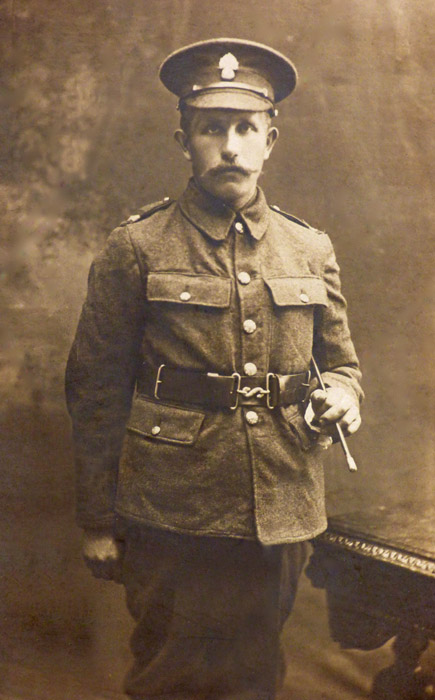
Private 2610, 9th Battalion, Royal Fusiliers (City of London Regiment).
Died 03/10/1916. Age 27.
Husband of Daisy, Father of six children.
Commemorated on the Thiepval Memorial
Parents and Childhood Family
James was the son of Samuel and Louisa Fiske of Turnpike Road, Marlesford. Samuel (b. Dennington, 1849) was a gardener's labourer and later became a carpenter. Samuel married Louise Meadows (b. 1856) in 1876. James was born in Marlesford in 1889, by which time Samuel and Louisa were living on ‘Road by Sandy Corner, past Church Farm to Gate House’, Marlesford.
James was one of eight siblings although the census records show only 4 survived childhood:
- Charles W. 1877-1960
- Florence Lucy 1880-1960
- Alice 1882 - ?
- Elizabeth Mary 1886-1973
- James 1889-1916
- George 1891 – ?
- Two others, not presently known
Note: The 1891 census also shows Elizabeth Coppon who was living as a ‘visitor’ at the house with an occupation as ‘Sick Nurse’. James’ descendants believe Alice died in infancy, although listed as nine years old on the census. George is not mentioned on future census. The 1911 census also tells us that Samuel and Louisa had eight children but only 4 survived.
Family and Pre-War
James married Daisy Alice Pratt of 1 Council Houses, Charsfield. Daisy was born between April and June 1889 in Farnham to parents George and Mary. In Daisy’s later life she returned to Charsfield, living at '15 South View', she died 14th April 1963.
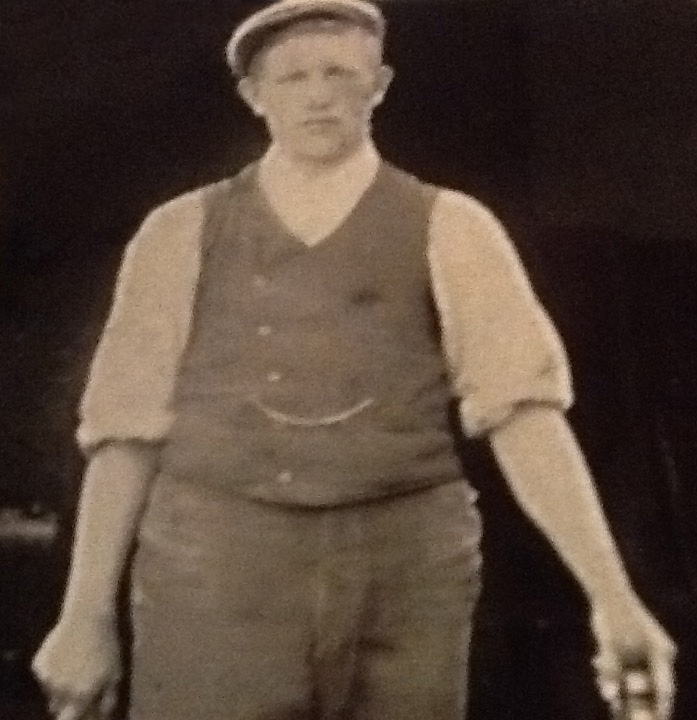
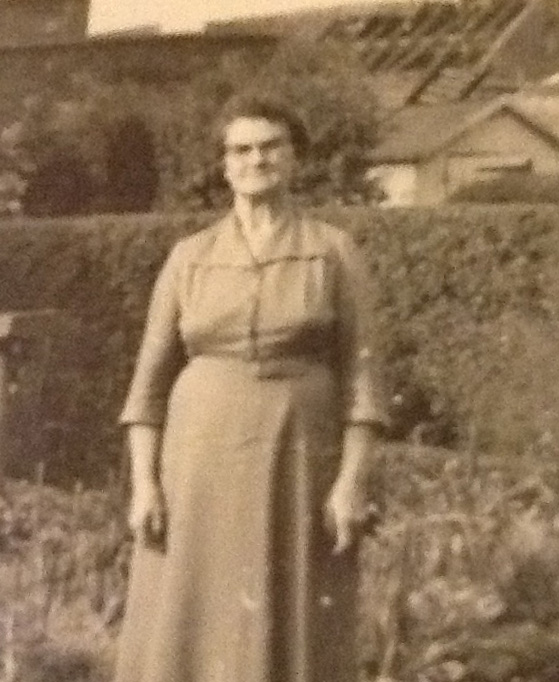
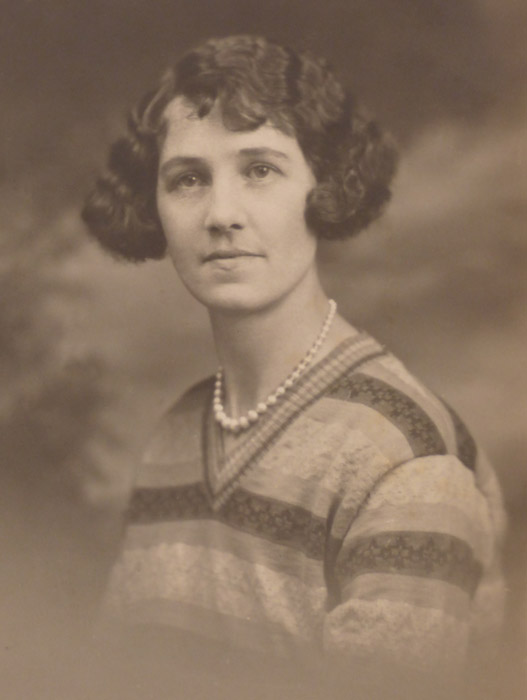
Left to Right: James, pre-war; His wife, Daisy Fisk (nee Pratt), Date Unknown; James’ Sister, Elizabeth Tatham (nee Fisk) Date Unknown.
James and Daisy married in 1909/10 with their first son John (likely to be John Harry) being born between January and March 1910 (possibly 20th February 1910).
In 1911 James was living with his parents, wife and child in the same property in Sandy Lane, Marlesford and he was employed as an estate labourer. The CWGC records show Samuel and Louisa living at ‘Rose Cottage’ Marlesford; we have yet to determine if this was on Sandy Corner.
James and Daisy had six children together:
- Grace 1908-1996
- John Harry (also known as Jack) 1910-1993. Born between January and March 1910 (possibly 20th February 1910)
- George William 1911-2001
- Alice Maud 1913-1983
- Sidney Ralph 1915-1987
- Vera Verden 16/10/1916-1998. Vera was born 13 days after her father had died.
Grace was sent to live with James’ sister Elizabeth, who was married to Jack Tatham (Blacksmith in Leyton, Essex) and was brought up with Eric their son. The siblings didn't meet up with Grace again until 1970's. According to the 1911 census, Grace was already living with Jack and Elizabeth. The record shows that James and Daisy already had two children but only John was living with them. Perhaps a sign of the times as they only married in 1910, two years after Grace was born!
It also appears that the family changed the spelling of their name at this time. On all census documents pertaining to James and his parents show the family name as ‘Fiske’. It appears that on his children’s and James’ war records, the ‘e’ had been dropped with the family referred to as ‘Fisk’.
Before the war James was a carpenter living in Marlesford, we assume remaining on the Marlesford Hall estate. The family moved to 1 the Council Houses, Charsfield at some point before enlistment and the children went to Dallinghoo School until its closure. Unfortunately Daisy burned much of James’ documented information after his death, which was common practice in many families. The photos of James, Daisy and Elizabeth we have published are the sole remaining documents, courtesy of his Granddaughter, Gill.
War Service
James’ service records have been lost (assumed destroyed in the Kew Blitz fires in the Second World War) and as stated above, the family destroyed records some time ago. The story laid out below has been put together from what records are available but naturally some assumptions have been made to form a fuller representation of what James’ war service probably entailed. We do not know for certain when he enlisted or first saw service overseas but the story below is the best representation that meets the limited facts we have. Hopefully further research at a future date can confirm or change the story.
Enlistment and Overseas
James enlisted in Framlingham. Many of the other Marlesford men enlisted together or earlier than James. James’ present day family do not know the circumstances of his enlistment. We do know from his medal index card that he did not go overseas until 1916 as he is not entitled to a 1915 Star. We also know that his sixth child, Vera was not born until October so it is reasonable to assume he did not go overseas until at least February 1916.
James joined the Royal Fusiliers (City of London Regiment) and was allocated the service number E/2610. This ‘E/’ prefix is typically assigned to the Royal Fusiliers 17th (Empire) Battalion although his Medal card states he first joined the 22nd Battalion and then moved to the 9th Battalion.
There is a good probability James signed up under the ‘Derby Scheme’. By the summer of 1915, the supply of new volunteers for service was dwindling and the government wanted a way to recruit more men without the need for conscription. Under the Derby Scheme, men of eligible age and fitness and working outside of a protected profession could ‘attest’ for service. They could enlist immediately or in the case of the vast majority, defer their service. Each person was assigned to a group based on age and marital statue. It was intended to ensure a regular supply of new recruits without conscription but in reality the numbers just weren’t enough and the groups were called up far more aggressively than envisaged. Full details of the Derby Scheme can be read here.
Under the Derby Scheme, recruits rarely had a say in which regiment in which they would serve. By 1916 a number of regiments and battalion groups had been established but were sustaining heavy losses on the front, therefore new entrants were needed as replacements and were therefore not forming new units. By joining the Royal Fusiliers and then with the change from 17th to 22nd and then the 9th Battalion fits this scheme, along with the timeframe of service (after February 1916 to his death on 3rd October 1916.
If we make this assumption, James, being a married man born in 1889 would have been allocated to group 32. He would have received his proclamation of services on 7th March 1916 for orders to report for training on 7th April 1916. At this time, 13 weeks basic training would be typical for an infantryman followed by one week of leave before being sent overseas. This would put James Fisk in France around 14th July 1916. This is not fixed as sometimes training was cut short or extended, but would fit the need to help replenish the massive losses sustained on the Somme.
9th Battalion, Royal Fusiliers (City of London Regiment), 36th Brigade, 12th Division
On the first day of the Somme, 1st July 1916 the 9th Royal Fusiliers were in the supporting ranks. The 1st July is rightly known for the immense loss of life however, the following five months contained a succession of battles where massive losses were sustained.
On 7th July, the 36th Brigade was involved in a battle to capture the town of Ovilliers. The 36th brigade consisted of: 8th and 9th Battalions, Royal Fusiliers (City of London Regiment); 7th Battalion, Royal Sussex Regiment; 11th Battalion, Duke of Cambridge's Own (Middlesex Regiment). On 7th July, the 9th Battalion was on the left flank, the 8th battalion on the right with the 7th Royal Sussex between them. The plan was to take Ovilliers from the south-west.
The attack started with a bombardment at 05:30 with the attack starting at 08:26. The weather was bad and fumes from Gas shells hung in the hollows of the ground forming a death trap for wounded. The attack moved forwards into withering machine gun fire and though the Germans first and second trenches were captured and shortly after noon, the Brigade held half of Ovilliers but the cost was immense. For the 8th Royal Fusiliers, every officer involved was killed, wounded or missing but they held the line until relieved the following day. The 8th battalion went into action with 800 men, that night the muster showed just 160. The 9th fought under the same conditions and had similar losses, in all 180 men held the line by night time – approximately 620 killed, wounded or missing. The War diaries describe “’A’ Company was decimated by machine gun fire, and the same fate met two platoons of ‘B’ which followed”. The Battalion was removed from the line the following day to Albert, eventually to Bus Les Atrois on 11th July for rest, given the battalion was down to approximately a quarter of its full strength.
The Battalion war diaries state a draft of 292 men arrived in Belle Eglise on the morning of the 15th July with a further 167 arriving on the afternoon of the 17th July. We cannot say for certain but it is possible James Fisk was part of this draft. Based on the assumptions already stated, the change from 22nd to 9th Battalions and the need to rush reinforcements to the front there is a good chance that James was part of this draft. The war diary doesn’t state any further drafts before James’ death in October, but in likelihood there were others, but they were not recorded. The best assumption is he arrived at some point between 15th July and the end of September, probably in the 15th July drafts or part if an unrecorded draft following the ‘Ration trench’ attack in early August 1916 (see later).
9th Fusiliers, post Ovilliers
The 9th battalion was next in action on 20th July in the trenches at Mailly Maillet where the majority of the time was spent improving the trenches following recent actions and there were a number of patrols. They were shelled on a number of occasions with ‘Several Casualties’. They were relieved on 24th retiring to Warnimont, then on the following days they went through Bertrancourt Forceville to Hedaville and on to Bouzincourt. The end of July and early August was spent in support trenches near Albert where the men were at the disposal of the commanders for working parties – this usually meant ‘fetching and carrying’ rations or equipment, trench or communication trench digging and other work duties.
On the 4th August the battalion moved from the Albert Defenses to take over ‘Avenue Trench’ with the intention of attacking ‘Ration Trench’ with the 8th Royal Fusillers and 7th Royal Sussex. The attack began at 21:15 and continued through a ‘heavy bombardment’ overnight. The attack was successful but is noted in history on the 6th August for the German counterattack where they used ‘Flammenwerfer’ or ‘Flame Throwers’. The war diaries state that 281 ‘Other Ranks’ were killed wounded or missing in the Ration Trench action that eventually completed on 7th August. Although no drafts are mentioned, it is possible James arrived as a replacement for these losses.
On 9th August 1916 the Battalion moved to Varennes where on the 10th August the 36th Brigade were inspected by ‘His Majesty the King, George V’. The next weeks are spent marching to new locations and work parties in the Simencourt area and then back to trenches on 21st August at Agny. For the remainder of August, Agny was a very ‘quiet’ sector for the battalion. There were few casualties from the periodic shelling, patrols and several ‘work parties’ which consumed most of their time. This quiet time was to end when orders came to move sectors at the end of September where they first moved to Dainville, then to Simencourt and then on to Neuvillette. They boarded motor transport bound for Albert via the route Doullens – Beauval – Talmas - Villersbocage – Rainneville – Querrieu finishin South-West of Albert on the Amiens-Albert road then marching the via Dernancourt – Meaulte – Fricourt – Mametz with bivouacs at Pommier Redoubt.
October 1916
On the 1st October 1916 James Fisk started his final journey. The battalion moved off from Camp at 4:30pm, and marched to the trenches west of Gueudecourt, via Montauban, Longueval, Delville Wood and Flers to relieve the 23rd Middlesex in the line at 11:15pm
C and B Companies were in the Front Line in ‘Gird Support trench’, the advanced strong point. A and D Companies formed a Support line in Gird Trench. This area had been heavily fought over for a number of weeks with the British slowly advancing through this previously held German territory. Although the term ‘trench’ is used, this was probably more a succession of shell holes joined together. The war diary extracts below state ‘linking up strong points’ and ‘linking up right and left companies’. This reinforces the opinion that the ‘front line’ was weak defensively and protection limited for the defenders. The 9th Battalion war diaries do not state the exact location and the trench maps that I have identified, do not show ‘Gird trench’. The British were attacking at this time so maps were in constant change as the lines moved. However, the war diaries of the battalion they relived, the 23rd Middlesex and company that relived them, 11th Middlesex do state locations.
The 23rd Middlesex state they “held each side of sunken road at N26 a 3.8 to N26 B 0.8. Enemy about 350 yards distant”, “ 20th D.L.I on left at N19 D.9.7. 9th Leicesters on right at N26 B 0.8.and they were relieved by 9th Royal Fusiliers”. This position is denoted on map 1, below, by the Blue Line.
The 11th Middlesex go into more detail. “Battalion relieved 9th Royal fusiliers in front line trenches. B Company from N26 B.0.9 to N20 C.6.5. D company thence to N20 C.3.9”. This is denoted by the Red line on Map 1. “A and C Companies in support in GIRD Trench from N20 C.30.25 to N26 C 3.4.” Shown by the Green line and “Battalion HQ at N31 B 4.1-7 Royal Sussex on left 37 brigade on the right” The Battalion HQ is denoted by the Orange dot on Map 1.
There is a slight discrepancy between these accounts but given the interpretation of location based on the maps at the time, this is understandable.

Map 1 - Trench positions at the start of October 1916
Red Line – Front Line Trench position as stated by the 11th Middlesex (Reliving Battalion)
Green Line - Support Trench position as stated by the 11th Middlesex
Orange Dot – Battalion HQ as stated by the 11th Middlesex
Blue Line - Front Line Trench position as stated by the 23rd Middlesex (Relieved by 9th Fusiliers)
There was a major attack planned for the 7th October which the Germans probably knew about, therefore the area was under sustained heavy bombardment. From the war diaries the shelling was pretty much continuous but the men had to continue working to maintain the defensive positions to enable the forthcoming attack. As this shelling was intended to disrupt the trenches, they are likely to have been heavy explosive shells to destroy the trenches and any dugouts present.
Extract from 9th Battalion War Diaries. 2nd October - Heavy shelling by the enemy all day long, particularly from 2pm – 4pm when a heavy barrage was put on the whole of our FRONT LINE, causing much damage to our trenches and a number of casualties were sustained. A large number of ‘blind’ shells fell into GIRD TRENCH. C Company sent out on patrol in front who found nothing of importance to report. Much work was done in linking up the strong points in front and also linking up the RIGHT and LEFT companies. Also work was done on a new communication trench to the FRONT LINE and the fire trenches deepened, all being shallow and in a shocking condition from the bad weather and heavy shelling.
3rd October - Heavy, hostile shelling of our trenches, more or less continuous throughout the day. Work on the damaged trenches rendered extremely difficult by the very bad weather and shelling. 2nd Lieutenants BARBER killed and 2nd Lt COPP wounded, a fair number of casualties among other ranks being sustained.
Battalion relived by the 11th battalion Middlesex at 11pm, went back to reserve trenches SOUTH EAST of FLERS. [Trench name] were in a very bad condition, the men mostly sleeping and resting in shell holes on top. Sussex and Middlesex in front line and 8th Battalion in support [assume 8th Royal Fusiliers].
Further transcripts of the war diaries can be read here.
James Fisk was killed on 3rd October 1916. This was very likely to be a consequence of the shelling the men endured. The 9th Battalion lost thirteen men on 3rd October; only four have known graves. Those four, 2nd Lieutenant Barber is listed as killed in action in the 9th Fusiliers War diaries and buried at ‘The Guards Cemetery’ but not known if that was a his original grave or moved later. Private Arthur Rees is buried at ‘Bancourt British Cemetery’ which was a consolidation cemetery established in September 1918. Private Frederick Grimshaw is buried at Dartmoor cemetery which was associated with the XV Corps Main Dressing Station at the time (Dressing stations were the first stop for Ambulances after the front before moving to a Casualty Clearing Station) so possibly died on the same day as wounding. Private Prunty died and buried at the Casualty clearing station at Heilly, which was some distance away so likely wounded previously. As an indication of the nature of the shelling in that area, the 11th Middlesex Battalion, who relived the 9th Fusiliers on the night of the 3rd October, lost a further eleven killed, only four of which have known graves.
The remaining casualties have no known grave and commemorated on the Thiepval memorial to the missing. It is not known if they were buried at the time, the near the trenches and the grave lost in subsequent shelling or as in the case of many casualties of heavy shelling, simply disappeared.
Modern Maps
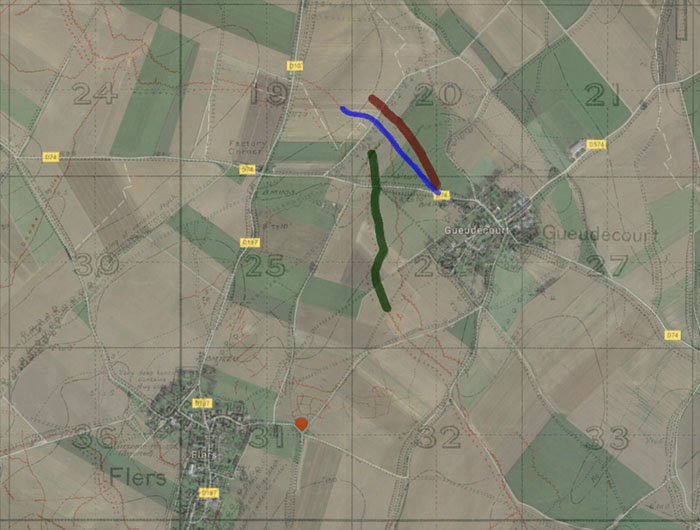
Map 2 – Modern Satellite overlaid with the Trench map and 9th Fusiliers lines in October 1916

Map 3 – Modern Satellite overlaid 9th Fusiliers lines in October 1916
Red Line – Front Line Trench position as stated by the 11th Middlesex (Reliving Battalion)
Green Line - Support Trench position as stated by the 11th Middlesex
Orange Dot – Battalion HQ as stated by the 11th Middlesex
Blue Line - Front Line Trench position as stated by the 23rd Middlesex (Relieved by 9th Fusiliers)
Commemoration
James Fisk has no known grave. He is commemorated on the Thiepval Memorial alongside over 72000 other names of those who were never found or identified.
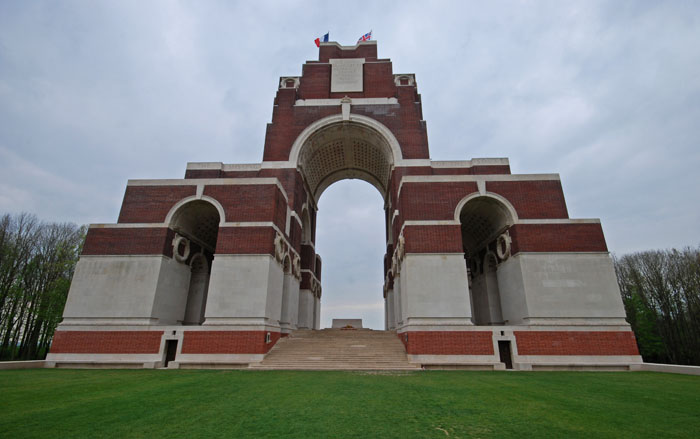
The Fusiliers are named (amongst others) on Panel 16A, which is on the far right of the above picture.
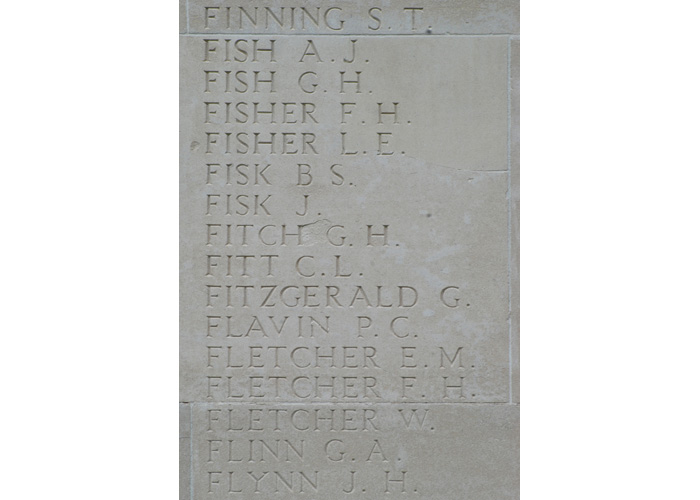
Close up for panel 16A.
The final resting place of James is pure speculation. He may be among the many thousands of casualties that remain to this day in the battlefield, where they fell. If he was buried, the grave may have been lost in future action or as with many graves, moved after the war to concentration cemeteries. From the CWGC website, speculation on James final resting place can be read here.
Acknowledgements
James Fisk has four living grandchildren, one of which is Gill Girling, Daughter of James’ son, George.
We would like to extend a special ‘thank you’ to Gill, for providing the photograph of James along with information on the family. We would also like to thank her daughter Claire Mould, for finding the website and making contact.
If any you have any further information on James and his family or have knowledge of the events I've stated here, please contact us here using the form.
